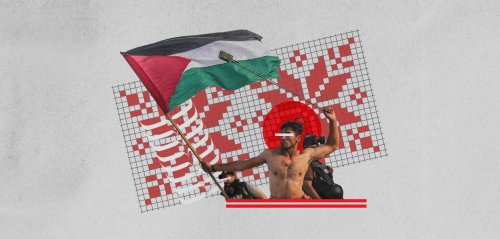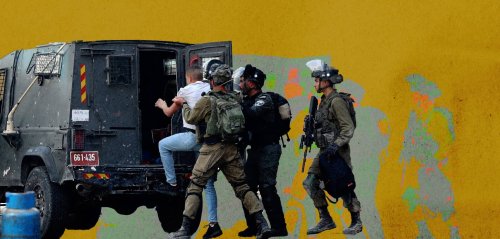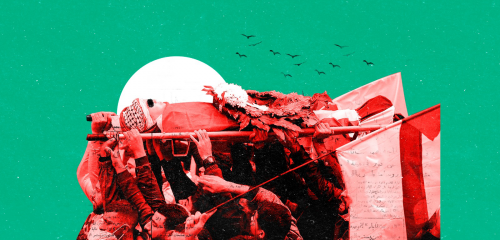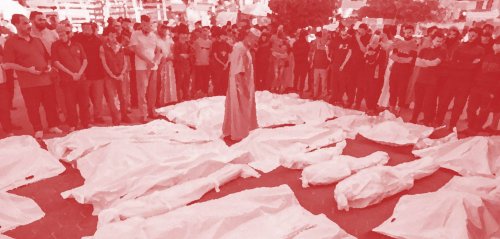Since October 7, Israel has been waging its most brutal war on the besieged Gaza Strip, with over 12,000 killed and 30,000 wounded. Since the start of the war, Israel has committed sudden attacks deemed war crimes, according to international human rights organizations, targeting hospitals, schools, civilian facilities, and international entities. The violence has spread to the occupied West Bank, with a rise in assaults, abuse, torture, and killings.
Israel persists in its war on the ‘Palestinian body’, a violent campaign that began long before the Nakba of 1948. However, the assaults, acts of humiliation, violation of privacy and dignity have escalated, becoming more cruel than ever.
The expansion of practices involving insults, sexual assault, stripping, intrusive searches, forcing individuals to kiss the Israeli flag or stand for the Israeli national anthem, all while being filmed for wide-scale circulation, marks a dangerous precedent, according to human rights sources.
All the torture focused on “sensitive areas”
A number of displaced Palestinians, while on their way from northern Gaza to the south, reported instances of men and youth being stripped of their clothes and left naked, in an appalling public display of humiliation and torture.
Videos circulating online show naked Palestinian workers detained in Israel being kicked in their backsides or genitals. Similarly, some released workers in Gaza spoke of being held forcibly naked for days on end, being attacked by police dogs while tied up, being subjected to electric shock torture and having cigarettes extinguished on their bodies. All the torture “focused on sensitive areas.”
Images of Palestinian detainees and prisoners being transported naked have circulated across social media and the news, with some scenes showing them being beaten and ridiculed on film.
The Euro-Mediterranean Human Rights Monitor reports “documented instances of torture, humiliating abuse, and ill-treatment of Palestinian detainees” in the West Bank. According to the group, “many of the detainees are subjected to severe beatings, filmed without any clothes on, blindfolded, handcuffed, and forced to perform various acts against their will under the threat of torture.”
In a report published on November 8, Amnesty International stated it had testimonies and video evidence of “particularly chilling public displays of torture and humiliation.” The report continues, condemning the “numerous incidents of torture and other ill-treatment by Israeli forces including severe beatings and deliberate humiliation of Palestinians who are detained in dire conditions.”
These physical and sexual violations are not only limited to Palestinian men. Amnesty International spoke with two Palestinian women who were “arbitrarily detained for 14 hours at a police station in occupied East Jerusalem where they were humiliated, strip-searched, mocked and asked to curse Hamas. They were later released without charges.”
The expansion of practices involving insults, sexual assault, stripping, intrusive searches, forcing individuals to kiss the Israeli flag or stand for the Israeli national anthem, all while being filmed for wide-scale circulation, marks a dangerous precedent
A video was circulated on Palestinian media outlets apparently showing a female minor being subjected to a humiliating body search by Israeli army forces in the Shu'afat camp, in what is considered a clear examples of explicit sexual harassment.
Additionally, Israeli publication Haaretz conducted an investigation documenting a series of physical and sexual assault against three Palestinian residents of the occupied West Bank. The perpetrators were identified as soldiers from an Israeli army unit and a group of Israeli settlers. The violations included stripping the victims naked, filming them, urinating on two of them, extinguishing cigarettes on their bodies, attempting to pull out their nails, and attempted anal rape. The report stated that the torture lasted an entire day, and the three victims were subsequently transferred to a hospital in Ramallah following their release.
An Israeli army spokesperson disclosed to Haaretz that “due to the serious nature of the allegations, an investigation into the incident has been launched, and the army unit commander has been relieved of duty.” One of the three Palestinian victims, known as Abu Hassan, told the newspaper that the torture he endured was similar to that at Abu Ghraib, but that the perpetrator was Israeli, not American.
Abu Hassan believes he was targeted due to his activism work, protecting Palestinian shepherds from settler violence. According to Abu Hassan, “they wanted to send two messages: first, that the Jews went crazy [after the Hamas attack], and two, that we Arabs should not dare to mess with them.”
Prisoners, both male and female, remain the most vulnerable link in the chain of Israeli-inflicted torture and humiliation in Palestinian prisons. The Palestinian Commission of Prisoners and Ex-Prisoners Affairs has repeatedly emphasized that, in addition starvation, dehydration, power outages, denial of basic necessities, breaking limbs, and denial of medical treatment, prisoners endure “derogatory treatment, insults, verbal abuse, their hands bound behind their backs for extended periods of time, along with tight shackling to cut blood circulation, and demeaning strip searches.”
Detained writer Lama Khater told Palestinian lawyer Hassan Abadi that during an interrogation at the Kiryat Arba camp, she had been threatened with gang rape. Abadi explained on Facebook that “the officer threatened her: ‘I have 20 soldiers here; we are going to rape you like ‘your group’ raped our women.’ And added, ‘I want to detain your children and burn them to death.’ He maintained these threats throughout the interrogation, asserting, ‘You are war prisoners, and we can do whatever we want to you.’”
Abadi highlighted that Lama, alongside other female prisoners, regularly undergoes what the prisoners refer to as “searches of shame”, in addition to other gross violations such as starvation, being forced to drink water with chlorine, prolonged power and water cuts and having food and clothing confiscated on a regular basis.
"I want to detain your children and burn them to death", "I have 20 soldiers here; we are going to rape you", and "You are war prisoners, we can do whatever we want to you"... This is a small sample of the threats Palestinian prisoners hear on a daily basis
Examining the rise of this escalating violence
There is no doubt that Israelis may be seeking revenge for Operation Al-Aqsa Storm by seeking false ‘victories’ over the bodies of Palestinians. This has likely contributed to the recent unparalleled surge in Israeli violations against Palestinians, with a particular focus on sexual abuse.
Haaretz attributes the rise in violence to various factors, the first of which is the war, and “because most of the standing army forces were moved to southern Israel, most of the military force positioned in the West Bank now are reserves, which includes a large number of settlers who were called up.”
The second factor, according to Haaretz, is the increase in arms to already heavily-armed extremist settlers; “Under IDF directives, many settlers are allowed to bear arms, and there is an extensive and documented history of settlers committing violence or other illegal acts while armed with Israeli army rifles.” The Israeli newspaper adds that the "culture of threat and violence against Palestinian shepherd communities in the West Bank" had already greatly increased with the current government, but, since the start of this war, it has become a “tsunami”.
According to Haaretz, an increasing number of settlers are wearing military uniforms in order to commit violations against Palestinians as “the already blurred line between settlers and soldiers becomes more blurry.”
Israelis may be seeking revenge for Operation Al-Aqsa Storm by seeking false ‘victories’ over the bodies of Palestinians. This has likely contributed to the recent surge in Israeli violations against Palestinians, with a particular focus on sexual abuse.
The 'Palestinian body' as battleground
Assaults on the 'Palestinian body' has become an entrenched Israeli practice, with multiple attempts seeking to institutionalize and normalize this violence. In August 2013, an extremist settler group released a guide on “How to violate the Palestinian body and its privacy.” The Israeli Price Tag extremist group deem the violation of the 'Palestinian body' as the price to be paid by Arab s who have opposed the expansion of illegal settlements or conducted romantic relationships with Jewish women.
The guide, a comprehensive 32-page document that goes beyond incitement to hatred and revenge against Palestinian Arab citizens, also documents all the criminal actions committed by the Price Tag and Price Collection groups over a span of four years. This document was distributed to children and teenagers in Israeli settlements.
For a better understanding of the Zionist movement's objectives and the targeting of the ‘individual Palestinian body’, one can refer to Esmail Nashef’s study, “On the non-transformation in the Palestinian Cultural Discourse: The Palestinian Cultural Problem.” Nashef, a Palestinian researcher, considers the battle over “the body of the land; the collective body of society; and the body of the individual” to be at the core of the Palestine-Israel conflict. Britain and the Zionist movement sought to control this “sacred triad” for decades, in order to ensure a national homeland for the Jewish people in Palestine. According to Nashef, Israel continues this same quest for control.
Assaults on Palestinian bodies has become an entrenched Israeli practice, with several attempts to normalize and institutionalize this violence. In 2013, the extremist Price Tag group released a guide on “How to violate the Palestinian body and its privacy”
In his study, Nashef outlines 1948 as the year Palestinians lost the “body of the land”, the “collective body”, and the subsequent displacement of the “individual body” throughout the region. Nashef explains, “This moment intensified previous relationships to the extent that it became a foundational moment for subsequent events.” Whereas the “body of the land” served as the primary focus, or target, until 1948, “‘the collective body of society’ became the primary arena [of conflict] in the period that followed, establishing itself in 1967, at least on the Palestinian side, through the rise of Palestinian organizations as an expression of this collective body and its political will.”
Nashef explains that following the Oslo Accords, the “individual body” became of primary concern, and remains this way, shaping our present reality. “These basic processes that shaped the conflict's space and its different coordinates, serve as the backdrop in which Palestinian martyrdom emerged, and they are also somewhat objective in their relationships with individual will as an actor in the history it shapes.”
The Palestinian ‘body’, according to Nashef, is at the heart of the conflict. He explains, “The correlation is anything but coincidental. The body, be it individual or collective in the Palestinian context, assumes the role of the direct battleground in Palestine, whether settled or displaced, each time the conflict escalates in its recurrent patterns. The fundamental axis of both colonial and, consequently, national conflict hinges on the will of the collective body, expressed through broader political will. This axis gains particular significance in settler colonialism, which is primarily based on eradicating existing collectives and reshaping local spaces to suit the machine extracting the colonizer's material and symbolic surplus for the settler.”
"The visible torture and killing of Palestinians.. is an Israeli policy aimed to culturally eradicate the infrastructure of resistance, struggle, and solidarity," keeping Palesinians preoccupied with daily survival
Many share the same perspective, including sociologist and anthropologist Bilal Awad Salameh. In his study titled “Palestinian Martyrdom Operations... The Palestinian Body as an Instrument of Resistance”, Salameh affirms that “The 'Palestinian body' represents a rolling and continuously evolving ideology throughout the phases of the Palestinian struggle, which made the physical human body an implement of resistance deriving its designation from the dictates of the objective conditions of history predicated on the sacred triad of ‘the body of the land; the body of society; and the body of the individual’... a triad where, as one weakens or recedes, the martyr advances to form a nurturing entity, staunchly defending the idea of existence manifested in the ‘sacred triad’.”
Expanding on this, Salameh writes in his book, On the Meaning of the Land... Reclaiming Palestinian Identity, that “the Palestinians and their presence on their land, and their natural growth, pose a security dilemma and a demographic problem, as witnessed in the 1948 camps... The land is the primary target, and the population is secondary. If the colonizers fail in the actual, cultural, or even symbolic erasure through policies of social, political, and economic exclusion and displacement, they resort to containment, assimilation and fragmentation policies. These policies may be 'more effective in getting rid of the original than genocide' because through these policies, Palestinians are 'mere biological entities, not political.' This approach opposes Palestinian existence and resistance within a state of isolation in their camps.”
He further notes that “The engineering of the place and control over Palestinian geography are not isolated from control over the Palestinians and their time. Control over the land is also a policy directed at shaping the Palestinian's consciousness that is associated with place, identity, and formation. This control intensifies political awareness for the Palestinian, linked to place, identity, and structure. This, in turn, affects the self-awareness of the camps and their localized rather than national identity due to geographic fragmentation and a matrix of barriers, surrounded by a series of exclusions, determining who has the right to enter or move in and out – a part of the mechanisms controlling Palestinians' bodies and reinforcing control over them.”
Researcher Esmail Nashef considers the “sacred triad”, or “the body of the land; the collective body of society; and the body of the individual” at the core of the Palestine-Israel conflict.
Salameh continues, outlining that even time is used to control Palestinians. "Even Palestinian time has been controlled, dominated and regulated. Deliberately wasting time for Palestinians, an ancient yet newly applied policy, serves to subvert and confine Palestinians by squandering and dissipating their time. The security apparatus, especially through military checkpoints post the 2000 uprising, coupled with the web of closures and daily humiliations of Palestinian dignity, has played a pivotal role in this. The 'Palestinian body' was targeted to dismantle it on both personal and collective levels, to domesticate it and prevent it from controlling its time. It aimed to shape a new concept of self. This social assimilation policy born from the security system affected some by inducing them to surrender their wasted selves to others.”
Extinguishing the infrastructure of resilience
The use of terror and intimidation and the increased killings at checkpoints during the uprising in 2015, does not differ much from the targeting of “Palestinian activists and resistance fighters in prisons or at checkpoints,” according to Salameh. He underscores that all these methods share a common goal, “to strike the concept of resistance within the Palestinian self and dismantle it, preventing [resistance and rebellion].”
According to Bilal Awad Salameh, by publicizing the torture of Palestinians, Israel seeks to “extinguish the infrastructure of resilience, forcing the Palestinian individual to crumble within, driving them toward self-destruction"
“Various forms of torture – from stripping prisoners and pulling out their nails to making them sit on the mouths of glass bottles, releasing police dogs on them, are tactics that were employed in the 1970s,” Salameh continues, explaining that the recurring and sustained use of such methods of torture during interrogations, are “nothing but policies aimed at erasing resistance and rebellion within the Palestinian [community].”
Such manipulation and isolation is exactly what Israel seeks to achieve. Salameh goes on to explain that by generalizing “scenes of killing and torture” and announcing them in order to “destroy the existential foundation of humans in a collective form, which is still alive,” Israel seeks to terrorize Palestinians. By publicizing the torture and killing of Palestinians, Israel seeks to “eradicate the infrastructure of resistance, struggle, and solidarity” and “extinguish the spirit of community and the infrastructure of resilience, forcing the Palestinian individual to crumble within, driving them toward self-destruction and preoccupation with daily survival.”
Numerous testimonies from victims of torture in recent days detail their the soldiers and settlers’ adamance to film their victims under torture, particularly naked or in humiliating positions. Many of these videos have been widely, and proudly, shared online.
Raseef22 is a not for profit entity. Our focus is on quality journalism. Every contribution to the NasRaseef membership goes directly towards journalism production. We stand independent, not accepting corporate sponsorships, sponsored content or political funding.
Support our mission to keep Raseef22 available to all readers by clicking here!
Interested in writing with us? Check our pitch process here!







